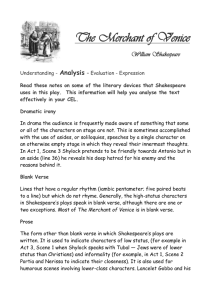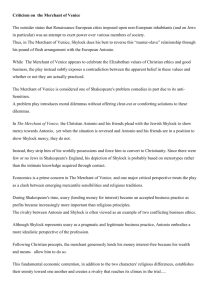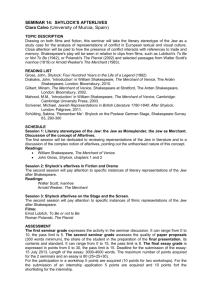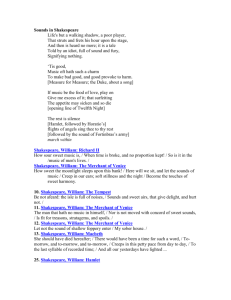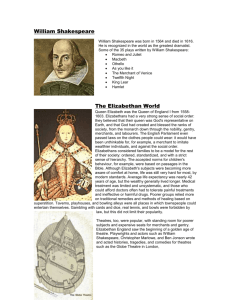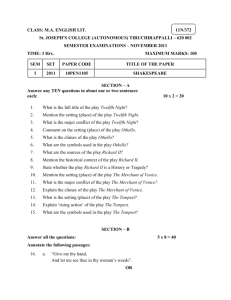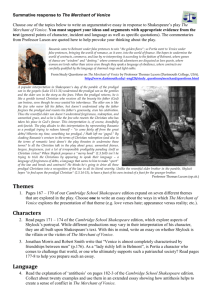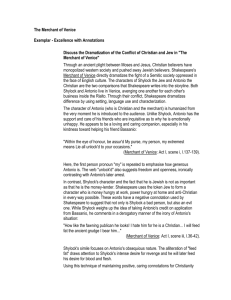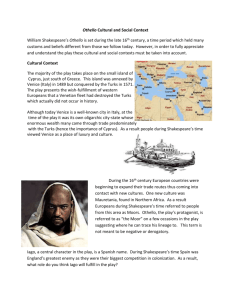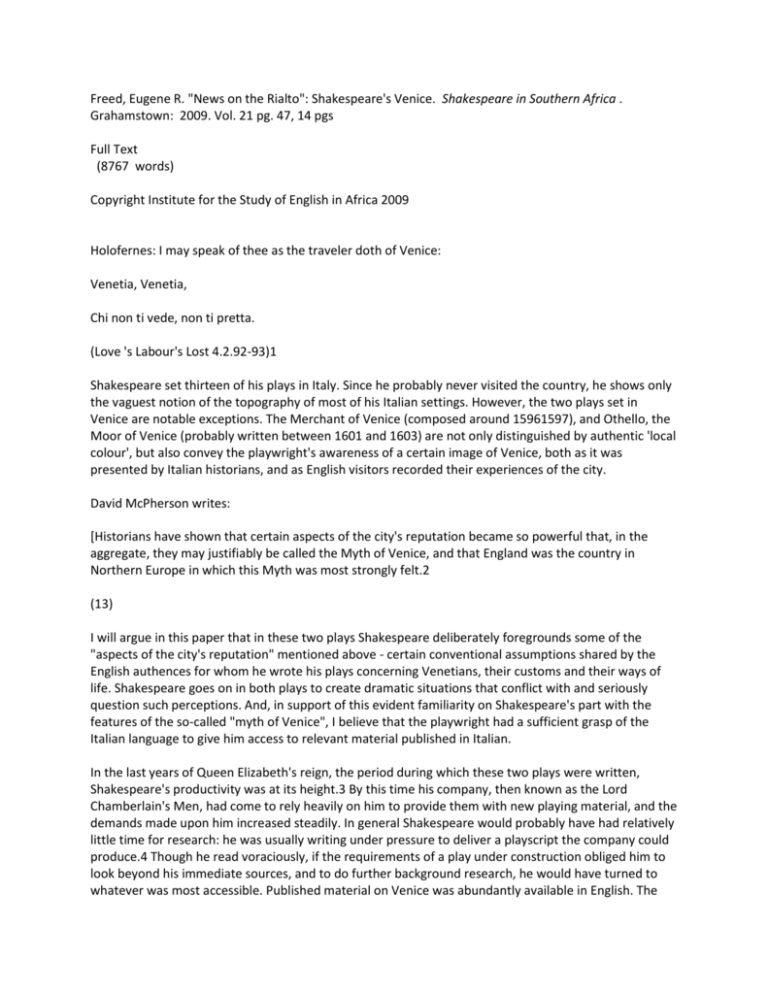
Freed, Eugene R. "News on the Rialto": Shakespeare's Venice. Shakespeare in Southern Africa .
Grahamstown: 2009. Vol. 21 pg. 47, 14 pgs
Full Text
(8767 words)
Copyright Institute for the Study of English in Africa 2009
Holofernes: I may speak of thee as the traveler doth of Venice:
Venetia, Venetia,
Chi non ti vede, non ti pretta.
(Love 's Labour's Lost 4.2.92-93)1
Shakespeare set thirteen of his plays in Italy. Since he probably never visited the country, he shows only
the vaguest notion of the topography of most of his Italian settings. However, the two plays set in
Venice are notable exceptions. The Merchant of Venice (composed around 15961597), and Othello, the
Moor of Venice (probably written between 1601 and 1603) are not only distinguished by authentic 'local
colour', but also convey the playwright's awareness of a certain image of Venice, both as it was
presented by Italian historians, and as English visitors recorded their experiences of the city.
David McPherson writes:
[Historians have shown that certain aspects of the city's reputation became so powerful that, in the
aggregate, they may justifiably be called the Myth of Venice, and that England was the country in
Northern Europe in which this Myth was most strongly felt.2
(13)
I will argue in this paper that in these two plays Shakespeare deliberately foregrounds some of the
"aspects of the city's reputation" mentioned above - certain conventional assumptions shared by the
English authences for whom he wrote his plays concerning Venetians, their customs and their ways of
life. Shakespeare goes on in both plays to create dramatic situations that conflict with and seriously
question such perceptions. And, in support of this evident familiarity on Shakespeare's part with the
features of the so-called "myth of Venice", I believe that the playwright had a sufficient grasp of the
Italian language to give him access to relevant material published in Italian.
In the last years of Queen Elizabeth's reign, the period during which these two plays were written,
Shakespeare's productivity was at its height.3 By this time his company, then known as the Lord
Chamberlain's Men, had come to rely heavily on him to provide them with new playing material, and the
demands made upon him increased steadily. In general Shakespeare would probably have had relatively
little time for research: he was usually writing under pressure to deliver a playscript the company could
produce.4 Though he read voraciously, if the requirements of a play under construction obliged him to
look beyond his immediate sources, and to do further background research, he would have turned to
whatever was most accessible. Published material on Venice was abundantly available in English. The
city's unique island situation, its canals and gondolieri, its celebrated carnivals - literate and even
illiterate people in London could have read or heard of these things. Those who read widely, those who
actually traveled, those who socialised with the intelligentsia, might have learned as well about the city's
legendary wealth, its republican political organisation and its Jewish community. Shakespeare had not
only read about the city, but may also have absorbed information about its history, its customs and its
populace from acquaintances who had visited or lived there.
One account of Venice and Venetian life that Shakespeare is likely to have consulted appears in a History
of Italy by William Thomas, published in 1549. While he was working on The Merchant of Venice
Shakespeare seems also to have read a famous history of Venice by Cardinal Gasparo Contarini originally published in Latin, but widely available in an Italian translation.5 Contarini's work appeared in
its first English translation, by Sir Lewis Lewkenor, only in 1599 perhaps two years after the first stage
production of The Merchant of Venice.6 Lewkenor' s translation (which contained a good deal of
additional material), prefaced by commendatory sonnets by Spenser and others, was greatly praised and
widely read.7 Ben Jonson's intellectual snob Sir Politic Would-Be (in Volpone, composed and produced
in 1605) boasts that because he had read Contarini's history, everyone took him for a citizen of Venice
within a week of his arrival there (4.1.37-40). But Shakespeare may have consulted Contarini's work in
an Italian version before the appearance of Lewkenor' s English translation. The Merchant of Venice is
based on a novella (or short story) by Ser Giovanni of Florence, first published in 1558; Othello on a
novella by Giraldi Cinthio, published in 1565.8 As far as I have been able to find out, no English
translation of either was available to Shakespeare at the time when he worked on the two plays. There
is thus a distinct possibility that Shakespeare read the two novelli, as well as Contarini's work, in Italian.
The Italian language and its culture were all the rage at the Elizabethan court. The Queen herself read,
wrote and spoke the language fluently, and had developed a taste for Italianate art, music, literature,
and architecture. Her courtiers followed her lead. The Earl of Southampton, Shakespeare's patron in the
early 1590s, was so determined to become fluent in Italian that he retained a private tutor during that
period and took lessons daily. The Earl's tutor was Dr. John Florio, a distinguished scholar who had
taught both Italian and French at Magdalen College, Oxford.9 In 1593-1594, while Shakespeare was
composing Venus and Adonis and The Rape of Lucrece (both of which he dedicated to the Earl of
Southampton), Florio was a regular presence in the Earl's London home, Southampton House in
Holborn. A severe outbreak of the plague had caused the closure of all theatrical venues in London for
most of the period from early in 1592 to the summer of 1594 (Schoenbaum 126-27 and Wood 146-48).
During this difficult time, some of Shakespeare's colleagues in the theatre were so hard pressed that
they were forced to pawn their theatrical costumes, and even their own clothes, while others tried to
maintain themselves through "the hand-to-mouth existence of the provincial circuit" (Schoenbaum 127).
Shakespeare's relationship of patronage with the wealthy young Earl gave him the moral and financial
support he needed to carry him through those tough times. The poet's gratitude is evident from the
warmth and apparent sincerity of the dedication of Lucrece to the Earl - leaving aside the contentious
question of whether or not Southampton was the patron to whom the poet expressed a similar sense of
indebtedness in the Sonnets.10
Details about Shakespeare's life are scarce and usually sketchy, and few of them remain unquestioned;
speculation about his career and his circle of acquaintances will inevitably be riddled with problems and
controversies. Dealing mainly with possibilities, one tries at best to exclude the more remote of these.
But the possibility that Shakespeare could have become acquainted with Florio during the early 1590s,
when both were close to the Earl, is strong. Florio had already published two language instruction
manuals expressly designed for teaching Italian to English-speakers: The First Fruites (1578) and The
Second Fruites (1591). Holofernes, showing off his knowledge of the Italian language in Love's Labour's
Lost (first produced in 1594), quotes the first part of a proverb that Florio had introduced into both
these manuals: Venetia, Venetia, chi non ti vede, non ti pretia ("Venice, Venice, who sees thee not,
cannot esteem thee").11 Florio may have been at work at this time on the first version of his
ItalianEnglish lexicon, A Worlde of Wordes, which he dedicated to the Earl of Southampton.12 Just as
later he helped Shakespeare's friend and rival Ben Jonson - who saluted Florio in a hand-written
dedication as "The ayde of his Muses"13 - so he may have encouraged Shakespeare in his reading of
both Italian and French sources, either actively, or by making his own published work available, and
perhaps even by sharing with the poet his yet-unpublished lexicon.
Alternatively, or in addition, Shakespeare could have turned to the library of an old friend: Richard Field,
the printer whose name appears on the title pages of both Venus and Adonis and The Rape of Lucrece
(Schoenbaum 130). Field, little more than two years older than Shakespeare, was born and had grown
up in a house a few hundred metres from Shakespeare's family home in Stratford-upon-Avon.14 As a
young man, Field went to London to be apprenticed in the printing trade. He served six of the seven
years of his apprenticeship with Thomas Vautrollier, a highly skilled French Huguenot printer who had
come to London from Troyes as a refugee. In the seventh and last year of apprenticeship, Field worked
in the printing shop of George Bishop. Field was 'made free' of the Stationers' Company just a few
months before Vautrollier's death in 1587, and in the following year (1588) married into Vautrollier's
family: either he married Vautrollier's widow Jacqueline, or his daughter, known as "Jacquenetta"
(Stopes 6-7 and Pogue 22).15 Through this highly convenient marriage, Field inherited not only a thriving
printing business, but also the publishing rights to all Vautrollier's imprints, and an extensive and
valuable library consisting of at least one copy of each imprint.
Shakespeare must have had personal contact with Richard Field in London, at the very least during the
periods while the two narrative poems were being prepared for publication (15931594). Shakespeare
would surely have wanted to proofread these 'first heirs of his invention' himself. When Shakespeare
first came to London, probably in the late 1580s, as a newcomer to the city, he may well have sought
out this old acquaintance from his home town. And perhaps he and Richard Field did find one another
congenial company.16 Field was not only associated with the printing of Shakespeare's two narrative
poems, but with the publication, or re-publication, of two of Shakespeare's most significant sourceworks: Sir Thomas North's translation of Plutarch's The Lives of the Noble Grecians and Romanes and
Raphael Holinshed's Chronicles.17 The presence of these and a long list of other Shakespearean sources
in Field's library is more than a coincidence: it suggests that Shakespeare may have made familiar and
effective use of this collection of books over a long period.18 Vautrollier had specialised in 'difficult'
books, many of them in foreign languages. Field continued his master's uncompromising tradition of
producing high-quality 'upmarket' work.19 Vautrollier was one of only two London printers who had
been awarded the right (which Field inherited) to "the sole printing of school-bookes" (Stopes 5). He and
Field were also "the leading publisher of language instruction manuals in Elizabethan London" (Kathman
2). Vautrollier's list had included the Campo di Fior of Claude de Sainliens (1583), intended "for the
furtherance of the learners of Latine, French, English, but chieflie of the Italian tongue", and Henry
Grantham's English translation of an Italian grammar originally written in Latin (1587).20
To sum up: if Shakespeare wished to acquire a reading or speaking knowledge of Italian (or, for that
matter, of French) there would have been no shortage of opportunity, either by live instruction or from
language manuals.
In reading Contarini's history of Venice, Shakespeare might well have been impressed by the author's
boundless enthusiasm for the city of his birth. Contarini boasted of "the greatness of the empire
thereunto belonging" (1), described its "traffique of all sortes of merchandise ... with all the nations of
the world" (3), noted "the wonderful concourse of strange and forraine people" (1), and praised (and
analysed in detail) the city's "institutions and lawes, prudently decreed [for the] security and happinesse
[of its citizens]" (5-6). Contarini had especially emphasised the centrality of the Rialto to the city's
history, and this may explain why Shakespeare places the Rialto, "which is the place where the
marchantes meet" (Contarini 153), at the core of Merchant. In the original story by Ser Giovanni, the
nameless Jew who lends money to the Venetian merchant Signor Ansaldo lives in Mestre, on the
mainland adjacent to Venice.21 Ser Giovanni never once mentions the Rialto, and leaves the local
topography of Venice vague. But in Shakespeare's play it is on the Rialto that Antonio, the Merchant of
Venice, and his friend Bassanio meet with Shylock the Jewish moneylender (1.3.30-32), and it is here
that Shylock confirms Antonio's credit-worthiness (14-18). Shylock reminds Antonio that it was on the
Rialto, amongst his business colleagues and in the public view, that Antonio insulted, demeaned and
physically abused him, on many occasions (98-100). It is on the Rialto too that Shylock hears of Antonio's
losses at sea, and exclaims in anger and contempt that this merchant of Venice, who "used to come so
smug upon the mart", is now "a bankrupt ... who dare scarce show his head on the Rialto" (3.1.1-6).
Both The Merchant of Venice and Othello include vivid splashes of 'local colour' which are absent from
their sources. In Merchant, Shylock's daughter Jessica elopes with her Christian lover Lorenzo in a
characteristically Venetian manner, in a gondola (2. 8. 7-9). 22 Though Cinthio's story of "Disdemona of
Venice and the Moorish Captain" offers no detail at all of the Venetian setting in which Disdemona
marries her Moor, Shakespeare's Othello introduces another gondolier, who - under cover of darkness transports Desdemona from her father's house to her assignation with Othello. Everyone had heard of
the gondoliers of Venice, but another detail concerning Venetian water-transport may have come from
an acquaintance who had actually traveled on it: the traghetto. When Portia sends her servant Balthazar
to fetch robes and documents from her lawyer cousin in Padua, on the mainland forty kilometers west
of Venice, she instructs Balthazar to meet her at the "common ferry/Which trades to Venice" (3.4.53-54)
from the mainland - the traghetto.23 Thomas Coryat, whose observations on the city were published
only in 1611, wrote of "ferries or passages [between Venice and the mainland] commonly called
traghetti" (311). "Magnificoes" officiate in the court of law in Merchant (4. LSD) and in Othello
"Senators" make decisions about the defence of the city in a council over which the Duke presides
(1.2.91-97), exactly as Contarmi (10-36) and Thomas (6978) describe the courts and government of
Venice. Portia's "sunny locks ... hangfing] on her temples like a golden fleece" (1.1.68-69) imply not only
that she is rich and desirable, but also that, like other Venetian women of fashion in the sixteenth
century, she bleaches her hair blonde (McPherson 46). The "double ducats" Jessica steals from her
father Shylock were specifically a Venetian currency (2.8.17-19).24
The name of Lancelot Gobbo, the clownish servant of Shylock in Merchant, is an interesting detail. A
crouching stone figure known as il gobbo di Rialto, once an iconic symbol of Venice, can still be seen on
the Rialto.25 The figure supports on its bent back a flight of stone steps that were formerly used as a
podium from which Venetian laws were promulgated, and from which the names of offenders were
read out. Anti-authoritarian jokes and satires were often attached to this statue, and were attributed to
U gobo (Elze 281). "Gobbo" is thus the perfect name for the kind of irreverent clown Shakespeare
depicts in Lancelot.
Almost every sixteenth-century English traveler who published an account of Venice mentions its Jewish
community, probably because the average English person of the time had never actually met a Jew
(McPherson 62). 26 King Edward I had expelled the entire Jewish population of England in 1290, after
confiscating all their goods and property. Jews were not officially re-admitted to the country until forty
years after Shakespeare's death (Shapiro 46-55). Since it is most unlikely that Shakespeare himself ever
encountered a Jewish community, his evocation in Merchant of Shylock in his social context is an
imaginative projection, and is all the more remarkable for that.
In the late sixteenth and early seventeenth centuries, Venice was famed especially for three things: its
riches, its republican system of government, and its reputation as Venezia-cittàgalante, a city of pleasure
(Gaeta 60). The fabled wealth of Venice originated from its trade with the East. The merchants of the
city had monopolised the trade in Eastern spices and luxury goods like silks and carpets, receiving them
by overland routes and exporting them by sea, together with Venice's own fine textiles and distinctive
glassware. Salerio in Merchant assumes (probably correctly) that the cargoes of Antonio's vessels consist
of spices and silks, no doubt from India (1.1.33-34). In order to protect its wealth, Venice had built itself
into a formidable military power. Its combination of economic and military might attracted traders "of
the furthest and remotest nations" (Contarmi 1), giving the city its distinctively cosmopolitan
atmosphere. A German visitor, Sebastian Münster, described Venice in 1544 as "superlatively
magnificent, beautiful and rich ... inhabited by huge throngs of people of various races, indeed from
virtually all nations" (McPherson 30).
However, Venetian power and wealth were waning during the sixteenth century. The Portuguese sailors
who opened up the sea-route to the East via the southern tip of Africa in the late fifteenth century,
seriously prejudiced the economy of the Venetian Republic. Moreover, Turkish power was moving
inexorably into territories formerly ruled by Venice, like the island of Cyprus (which the Turks in
historical fact conquered and occupied in 1571-1573).27 The Venetian Republic is in need of the services
of Othello, a foreign professional soldier, to defend its occupation of Cyprus Othello 1.3.222-223).
Contarmi writes of "forrain men and strangers . . . [who] have been adopted [as citizens] . . . [because]
they have been dutifull towards the state, or els had done them some notable service" (18). Othello is
just such a person. "I have done the state some service," he declares, "and they know't" (5.2.337).
Venice was perceived as well and wisely governed. The Doge (whom Shakespeare calls "the Duke" in
both plays) was appointed for life, by an election process that involved the drawing of lots among
certain noble families. But, as William Thomas commented, "though in appearance he seemeth of great
estate, yet in very deed his power is but small" (70). In the midnight consultation that takes place in
Othello concerning emergency preparations for war against the Turks, Shakespeare demonstrates
Contarini's emphatic assertion that the Doge could rule only with the consensus of his Council (1.3).28
The judicial system of Venice was widely praised for its freedom from corruption. Ser Giovanni had
noted that "Venice was a city ruled by law" (Spencer 190); in Merchant the Doge himself "cannot deny
the course of law" (3.3.26).29 The courts of the Venetian Republic were accessible not only to
Venetians, but also to those regarded as "strangers", which would include both Shylock and Othello. Ser
Giovanni asserted that the Jew of Mestre "had his legal rights stated fully and in public form" and that
therefore "nobody dared to oppose him - they could only entreat him" (Spencer 190). Referring to the
legal tussle between Signor Ansaldo and the Jew of Mestre, which has become a public scandal, a
Venetian inn-keeper in Ser Giovanni's story complains that "there is too much justice here [in Venice]"
(191). Indeed, Contarmi explains that "forrayners and strangers" are in fact privileged in Venetian
courts: "[they] should not be molested and lingred off with long délayes, but quickly come to an ende of
their suites" (105). Antonio in Merchant affirms "the commodity that strangers have/With us in Venice
.../Since that the trade and profit of the city/Consisteth of all nations" (3.3.26-31).
But Venetian justice was as cruel as it was impartial. The "Officers of the Night" on whom Brabantio calls
in his search for his runaway daughter Desdemona Othello 1.1.180) were notorious for torturing
suspects in order to obtain confessions (McPherson 37-38). When Iago refuses to speak after his
treachery is revealed, the Venetian Gratiano says meaningfully to him 'Torments will ope your lips"
(5.2.302). Iago will be subjected to "cunning cruelty/That can torment him much and hold him long"
(331-32) - he will be forced to undergo intolerable pain, but will be kept alive as long as possible to
extend his suffering.30 While authences of the play must feel that Iago richly deserves such treatment,
this was the dark underside of Venetian justice. Portia's resonant invocation in the court-room to "the
quality of mercy" (4.1.180-201) may begin to ring a little hollow in that particular historical context.
Venice was renowned as the 'pleasure capital' of Europe. Noting that "he that dwelleth in Venice may
reckon himself exempt from subjection", William Thomas speculated that this may be "one of the
principal causes that draweth so many strangers thither" (83). Contarini rhapsodised about "the
delicacie of [Venetian] entertainments, the beauty, pomp and daintines of their women, & finally the
infinite superfluities of all pleasure and delightes" (A2). For visitors as well as for most Venetians, these
delights included the colourful festivities and masquerades of the Venetian Carnival. But to some, the
'liberty' of Venice verged upon 'libertinism'. Shylock complains prudishly when "Christian fools with
painted faces" fill the air with drumming and "the vile squealing of the wry-necked fife" (2.5.29-32).
Appropriately, the noisy celebrations provide his daughter Jessica with the opportunity to escape from
her father's puritanical custody. Masked and dressed as a boy, she slips out of Shylock' s house to
become Lorenzo's "torchbearer", as they mingle with other revellers in the streets (2.6.39-41 and 5960).
Visitors to Venice in the sixteenth century never failed to comment on the multitude of prostitutes
plying their trade in the city. Venetian courtesans were famed for their beauty and sensuality. No other
city, Thomas declared, could "compare with Venice for the number of gorgeous dames" (83). Thomas
Coryat, noting the "very great" number of courtesans in Venice, confirmed that "...so infinite are the
allurements of these amorous Calypsoes, that the fame of them hath drawen many to Venice from some
of the remotest parts of Christendome, to contemplate their beauties, and enjoy their pleasing
dalliances" (402). Long before and long after the first production of Othello, Venetians (both men and
women) were commonly spoken of as being sexually licentious. The "exemption] from subjection" (to a
moral code) to which William Thomas had alluded in the mid-sixteenth century, was noted again by
James Howell, an English visitor in the mid-seventeenth century: "Venice is taxd the World over for the
latitude of liberty She gives for carnali pleasure, and the large conscience She hath under the navill"
(quoted in McPherson 43). A century and a half later, Lord Byron asserted, from his own extensive
experience, that nothing had changed.31 This longstanding reputation (together with its mind-boggling
double-standard) allows Iago to get away with his claim that all Venetian women are lascivious. "I know
our country disposition well," he tells Othello:
In Venice they do let God see the pranks
They dare not show their husbands; their best conscience
Is not to leave 't undone, but keep't unknown.
(3.3.204-07)
Iago' s diabolical inference poisons Othello's mind, with tragic consequences. Aflame with jealousy,
Othello snarls at his innocent wife: "I took you for that cunning whore of Venice/That married with
Othello" (4.2.91-92). Iago has duped the Moor into accepting the widely received public image of the
licentious, untrustworthy Venetian woman, even though the truth staring Othello in the face is that his
wife Desdemona is chaste and unswervingly devoted to him. Here Shakespeare has manipulated a
perception associated with the "myth of Venice" in such a way as to make it the fulcrum upon which the
plot turns. Iago brands Desdemona as the conventionally licentious Venetian woman, and persuades her
husband to accept that view of his wife. Such stereotyping (it applies to Iago's presentation of the Moor
as well, though not in a specifically Venetian context) is revealed as tragically unjust.
Shakespeare has done something comparable with Shylock, whose very name stamps upon him the
stigma of the greedy Jewish usurer. The Venetian Republic did not merely tolerate Jews; from the early
years of the sixteenth century onwards, it actively encouraged them to live in the city. Certainly, they did
so under many limitations: among other prohibitions, they were forbidden to enter most trades and
professions (other than moneylending and pawnbroking), and were restricted to living in the
neighbourhood known locally as the 'Ghetto' - or getto - the first such enclave in Europe. The treatment
of Jews in sixteenth-century Venice was lenient only by comparison with the savagery of the
discrimination they faced elsewhere. But Venetian Jews did enjoy two significant rights denied to other
Jewish communities in Europe: they were free to practice their religion openly (the community
Shakespeare depicts in Merchant has a synagogue - 3.1.102-03) and they had the same legal rights and
access to the courts of law as Christian citizens.32 The whole of the fourth act of Merchant dramatises
Shylock' s encounter with Venetian justice.
The fact that Shylock is actually able to seek redress in a Venetian court would have been noteworthy to
English authences at a time when Jews had no legal rights at all in most of Europe. Moreover, Shylock
confidently expects a fair judgement, asserting in court "I stand here for the law" (4.1.143). Portia,
defending Antonio, is forced to admit that "Venetian law/Cannot impugn [Shylock]" (4.1.174-75). The
motives of the Venetian Republic in its relatively tolerant treatment of its Jewish community were
neither altruistic nor humanitarian. Jews provided the Venetian economy with an essential service:
moneylending, which was forbidden to Christians. The government of Venice officially justified its
toleration of Jews by claiming that in this way they avoided a greater sin - usury, a form of avarice,
represented as the worst of the seven deadly sins in the later medieval period - by tolerating a lesser
one - the Jewish presence among Christians (see Pulían). The Republic did exceedingly well out of the
arrangement, imposing exorbitant taxes upon the profits of lending money. William Thomas
commented: "It is almost incredible what gain the Venetians receive by the usury of the Jews" (69).
Despite these huge taxes, the Venetian Jewish community contrived to prosper - Thomas described
them as "out of measure wealthy". Shakespeare could assume that his authences shared the view then
current of the wealthy and grasping Venetian Jewish moneylender.
Shakespeare built this stereotype into Shylock' s name. "Shalach" (rf?^), mentioned in Genesis 10:24, is
the name of a grandson of Noah's son Shem. Shakespeare found the names of Shylock' s co-religionists,
"Tubal" and "Chus" (otherwise "Cush", father of Nimrod the "mighty hunter") in the same chapter of
Genesis (10:2 and 10.6-8). The name rf?W (meaning "one sent away", possibly "a messenger") is
rendered as "Shelah" in the Geneva Bible. But, as Barbara K. Lewalski has pointed out, the most likely
Old Testament association with the name Shylock is "j^W, a homophone of the name in Genesis 10:24
(Lewalski 342).33 "ftw is rendered as "cormorant" in the English Bibles available to Shakespeare, in
Leviticus 11:17 and again in Deuteronomy 14:17, in a list of birds of prey whose flesh the Children of
Israel may not eat.34 In Elizabethan slang, the word "cormorant", with its associations of extreme
greediness, was a derogatory name for a moneylender.35 Just as Shakespeare went to some trouble to
find exactly the right name for his Venetian clown, so, evidently, he made the effort to find an
appropriate Hebrew name for the Jewish moneylender in his play.36 How would he have gone about
this? It need not have been especially difficult. Scholarship in Hebrew was highly esteemed in England at
this time, and was not uncommon amongst the well-educated; the language of the Old Testament was
taught to senior pupils at the better public schools.37 Shakespeare's circle of acquaintance probably
included someone who could have helped him here.
Antonio, the Merchant of the play's title, has grossly abused Shylock. He admits to it freely; indeed, he
all but brags about it. He has physically assaulted and verbally maligned Shylock repeatedly, in public, on
the Rialto, in the presence of his colleagues and fellow-traders. Shylock reminds him:
you spat on me on Wednesday last,
You spurned me such a day, another time
You called me dog
(1.3.118-20)
Antonio is unmoved. He responds: "I am as like to call thee so again,/To spit on thee again, to spurn thee
too" (1.3.122-23). Antonio's supremely arrogant assumption that - being a Christian - he is entitled to
revile and publicly humiliate Shylock the Jew, as and when he pleases, is surely more than flesh and
blood can bear. Shakespeare goes on to reveal that - strange to relate - Shylock the Jew is only human,
and like other human beings, is composed of flesh and blood. Shylock' s famous outburst at the play's
centre, in Merchant Act III scene I, makes exactly that point:
Hath not a Jew eyes? Hath not a Jew hands, organs, dimensions, senses, affections, passions? Fed with
the same food, hurt with the same weapons ... as a Christian is? If you prick us, do we not bleed? ... And
if you wrong us, shall we not revenge?
(3.1.46-52)
Shakespeare makes it very clear to his authence why, in this instance, Shylock, whose very name should
make him the embodiment of the usurer's greed for money, will not accept money. Ser Giovanni's 'Jew
of Mestre' refused money in lieu of his pound of flesh, wanting "to commit that homicide, in order to be
able to say that he had brought to death the greatest merchant there was among the Christians"
(Spencer 190). Something like this must figure in Shylock' s motivation as well: he too perceives Antonio
the merchant as representative of the social order that barely tolerates his existence and makes his life
hellish. Antonio, who voided his "rheum" upon Shylock' s beard and kicked him as one would a stray dog
(1.3.109-11), "laughed at my losses, mocked at my gains, scorned my nation ... and what's his reason? I
am a Jew" (3.1.44-46). But (partly by introducing the sub-plot involving Jessica, borrowed from
Marlowe's The Jew of Malta), Shakespeare furnishes Shylock with a far more intimate and compelling
motivation than Ser Giovanni gave to the Jew of Mestre. When Antonio spat in Shylock' s face on the
Rialto, in the full view of the mercantile community, he not only defiled Shylock as a human being, but
also stripped him of his personal dignity as a man. Facing Antonio on the way to the courts of law,
Shylock growls out an angry warning: "Thou call'dst me dog before thou hadst a cause,/But since I am a
dog, beware my fangs" (3.3.6-7). He is determined to take the pound of Antonio's flesh that the bond
specifies; he chooses to have that rather than any amount of money.38
Within the court, Shylock is offered twice the amount Antonio owes him, and even more (4.1.205-07).
He refuses the offer. Already seething with resentment at Antonio's treatment of him, Shylock has in
addition been cut to the quick by the rebellion of his own "flesh and blood" (3.1.30) - by his daughter's
lacerating rejection of him when she elopes with a Christian, taking with her as much of his wealth as
she can carry. By means of this sub-plot Shakespeare redoubles the Jew's motivation. In Shylock' s
suffering mind, if Antonio can be humiliated and his flesh slashed in the public view, it would be no more
than a fitting requital for the many public indignities to which the Merchant of Venice - and the Venetian
establishment he embodies - has subjected the body and the soul of Shylock the Jew. As it is, Antonio
narrowly escapes being forced to pay, literally with his own flesh and blood, for the accumulated insults
that flesh and blood could no longer endure. Here is a second Venetian stereotype, in a dramatic
situation that Shakespeare forces us, the authence, to scrutinise so closely that we experience
something like an emotional parallel to the cutting of living flesh.
In both these instances, the common perception is faulty, if not hopelessly inadequate. Desdemona is a
Venetian woman - but she does not in any way conform to the licentious type of the "cunning whore of
Venice". She truly loves her husband and is faithful to him. Shylock may be a Jew and a moneylender
(perhaps the latter from choice, though he would have had little leeway in his choice of a career) - but
Shakespeare's presentation of the Jew reveals that this 'monster' is really no more than another frail and
flawed creature of flesh and blood. Moved, like the rest of us, by "senses, affections, passions" (3.1.47),
he vehemently asserts the common humanity and common human failings of Jews like himself: "If you
prick us, do we not bleed? If you tickle us, do we not laugh? If you poison us, do we not die? And if you
wrong us, shall we not revenge?" (51-52).
Generations before Shakespeare's time, the medieval cycle plays in Europe and the Corpus Christi cycles
in England had created, and perpetuated, the convention of the 'stage Jew', epitomised by Caiaphas the
High Priest and his henchmen. Noting that "[a]nti-Jewishness was a structural feature of late medieval
society", Margaret Raftery comments on the 'typecasting' of Jews as they were represented on the
medieval stage. She writes that the plays
make use of [an] important form of contrast - with an alien 'Other' of Evil, represented in the main by
devils and Jews. These are two distinctly different 'enemies', yet ... they are sometimes conflated by
means of demonisation of the Jews ... In the medieval Christian mentality, Jews were thus firmly
situated on the side of the Devil, the primary referent for Otherness and Evil.
(42)
In 1579, what was perhaps the very last complete performance of a Corpus Christi 'mystery' cycle in
England took place in the streets and public squares of the city of Coventry. Since Coventry is only about
20 miles from Stratford-upon-Avon, a tradition has grown up that Shakespeare as a youth must have
witnessed this performance. If he did, then he may actually have seen such stage representations of the
Jew. Because of the role of the High Priest and the Pharisees in promoting the Crucifixion of Christ, Jews
on the stage were customarily reviled as evil, non-human, quasi-demonic.
But Shylock, as Shakespeare characterises him, is disconcertingly human - fully as human as any of the
Christians in the play. Like them, he has faults. For one thing, Shylock is materialistic; but is Bassanio
devoid of this fault? Having "disabled [his] estate" (1.1.169) by reckless spending, Bassanio' s pursuit of
Portia, whom he compares to a "golden fleece", is primarily motivated by a need "to get clear of all the
debts" he owes, including the large sums provided him by Antonio the Merchant (133). As for Antonio
himself, he has spent a lifetime in amassing a fortune, and it is he who supports and funds Bassanio's
quest for the hand of the golden heiress, borrowing heavily from Shylock for that purpose. And what
shall we say of Lorenzo, the young man-about-town who looks forward to a future "gild[ed]" with
Shylock' s ducats (2.6.5051)? Complacently he awaits the "gold and jewels" (2.4.31) with which Jessica
comes furnished, acquiring passively as much as she can bring him of Shylock' s hard-earned wealth which he and Jessica then proceed to squander with insane prodigality (3.1.85-97). Like any of these
men, Shylock has his weaknesses - and one of them is that, festering inwardly from Antonio's repeated
public assaults upon his dignity, he longs for revenge. The merchant of Venice has blandly assumed that,
as a Christian, it is his God-given right to shame, abuse and humiliate Shylock in the presence of his
peers, because Shylock is a Jew and a moneylender. Should Shylock meekly have turned the other cheek
to these assaults? Would Antonio have done so Shylock demands - if the situation had been reversed
(3.1.53-55)?
The Merchant of Venice is not formally a tragedy, but the disturbing consequences of Shakespeare's
refusal to 'typecast' Shylock the Jew, of allowing him both to say and to show that he is merely human,
does give this play a significant tragic dimension. The joy of the three marriages with which this
"comedy" conventionally ends is darkened, almost overshadowed, by hard questions left unresolved.
Which is undoubtedly what its author intended. Shakespeare's perception of Venetian life does indeed
embrace what modern scholars have called "the Myth of Venice", especially as it was known in England.
His two Venetian plays are authentic in terms of what was generally known about the city's physical
features, customs, festivals, government and judicial system. But they go further. They also explore and
seriously question entrenched views then current concerning Venetian (and other) manners and mores.
In each of these plays Shakespeare tests the validity of such a perception, thereby exposing the injustice
and, essentially, the foolishness of branding anyone, unthinkingly, with a stereotype.
At the end of Shakespeare's Venetian plays, both the 'comedy' and the monumentally grand tragedy, we
leave his theatre deeply and painfully discomfited.
[Footnote]
NOTES
1. All quotations from Shakespeare's plays are taken from Peter Alexander's edition of The Complete
Works, apart from The Merchant of Venice (ed. M.M. Mahood) and Othello (ed. E.A.J. Honigmann).
2. The historians McPherson cites include King and Queller.
3. Apart from Merchant and Othello, plays usually assigned to this period of Shakespeare's career
include: the comedies The Merry Wives of Windsor, Much Ado About Nothing, As You Like It, Twelfth
Night and Measure for Measure; possibly Troilus and Cressida; the histories Henry TV, parts I and II, and
Henry V; the tragedies Romeo and Juliet, Julius Caesar, Hamlet, Timon of Athens; and possibly King Lear.
4. Peter Thomson documents the time-pressures under which a company very much like Shakespeare's,
that of Philip Henslowe, worked during these years (58-78).
5. Contarini's history first appeared in 1543 as De Magistratibus etRepublica Venetorum ("The
Magistrates and Commonwealth of Venice").
6. Mahood discusses the dating of the first production in her Introduction to the play (1-2).
7. Spenser eulogised: "Fayre Venice, flower of the lost worlds delight . . . Yet not so fayre her buildings to
behold/As Lewkenors stile that hath her beautie told" (3v).
8. Ser Giovanni's "Gianetto of Venice and the Lady of Belmont" (from // Pecorone, 1558) and Cinthio's
"Disdemona of Venice and the Moorish Captain" (from Gli Hecatommithi, 1565) appear in modem
English translations by T.J.B. Spencer (177-210).
9. The most comprehensive account of Florio 's career in its historical context is still that of Francis
Yates. But see also the recent, broader study by Michael Wyatt.
10. The dedication in The Rape of Lucrece reads, "The love I dedicate to your Lordship is without end ...
What I have done is yours; what I have to doe is yours; being part in all I have, devoted yours"; from
Sonnet 37: "So I, made lame by Fortunes dearest spight/Take all my comfort from thy worth and truth"
(3-4) and "I in thy abundance am suffic'd,/And by a part of all thy glory live" (11-12). See the Nonesuch
edition of the Complete Works.
11. The proverb goes: Venetia, Venetia, chi non ti vede, non tipretia, ma chi ti vede ben gli costa. Florio
translates: "Who sees not Venice cannot esteeme it, But he that sees it payes well for it" ([A] 10607).
Yates (20-49) alleges that Holofernes was intended as a caricature of John Florio, but the light tone of
the play suggests rather that this character, with his weakness for showing off his pedantic learning,
constitutes an 'insider joke' that could have been appreciated and enjoyed by both Florio and the Earl of
Southampton. The garbled form in which the proverb appears in both the Quarto and the First Folio
versions of the play may even be intentional, and may be part of the joke.
12. The first edition of A Worlde ofWordes was published in 1598. By that time, as Florio implies in his
dedication, the Earl was so fluent in the Italian language that "I or mine [am] not now of further use to
your self-sufficiencie" (quoted in Wyatt 225).
13. A copy of Volpone now in the British Library was addressed by Jonson to "his loving Father, & worthy
Friend Mr. John Florio" with this inscription (McPherson 19).
14. For information about Field and his master Vautrollier, see Schoenbaum 130-32; David Kathman's
entry under "Richard Field" and Andrew Pettegree's under "Thomas Vautrollier" in the Oxford Dictionary
of National Biography; Kirkwood 1-39; Stopes 1-22; and Pogue 22-24. A listing of books in the British
Library known to have been printed by Thomas and Jacqueline Vautrollier and by Richard Field appears
at: http://www.sarahsmith.com/chasingshakesperes/book_and_background/
15. Shakespeare introduces a charming ingénue called "Jacquenetta" into Love 's Labour's Lost.
Vautrollier' s widow Jacqueline was a capable woman who had herself overseen the running of her
husband's printing-shop for long periods when he was abroad (Stopes 5-7). She took over the
management of the business after Vautrollier' s death. Her name appears either together with that of
her husband, or alone, on some of the imprints from the Vautrollier printing-house.
16. Charles Nicholl argues strongly that an ongoing relationship existed between Shakespeare and
Richard and Jacqueline (or "Jacquenetta") Field. Nicholl suggests that the French court depicted in
Shakespeare's Love 's Labour's Lost was inspired by the French-speaking circle of Huguenot émigrés
Shakespeare could have met at the Field home in Blackfriars (175-78).
17. North's Plutarch, published by Field in 1595, became the source ?? Julius Caesar, Antony and
Cleopatra, Coriolanus and Tintoti of Athens. The three-volume 1587 edition of Raphael Holinshed's
Chronicles, the source of all the "History" plays, of Macbeth and Cymbeline, and partly of King Lear, is
also connected with Field. George Bishop, Field's master in his final year of apprenticeship, was one of
the consortium of printers who published this edition of Holinshed; Richard Field was still serving the
last months of his indentures in Bishop's workshop when the Holinshed volumes were being prepared
there for publication. See Kathman (2).
18. This possibility was first pointed out by Stopes (2-3). A few of the other works of Shakespearean
interest that would have been on Field's shelves: Timothy Bright's Treatise of Melancholy, published by
Vautrollier in 1586, a source for Hamlet; Ovid's Metamorphoses, re-published by Field in 1589 from an
earlier edition brought out by Vautrollier - Shakespeare consulted this edition while composing Venus
and Adonis; Vautrollier' s 1574 edition of Ovid's Fasti, used by the poet while composing The Rape of
Lucrèce; George Puttenham's The Arte of English Poesie, published by Field in 1589, and frequently
consulted by Shakespeare; Sir John Harington's translation of Ariosto' s Orlando Furioso, published by
Field in 1591 - the primary source for Much Ado About Nothing; and Sir Phillip Sidney' s Arcadia,
published by Field in 1598 - a source for King Lear and other plays.
19. Richard Field rose eventually to the pinnacle of his profession. His name appears on the title pages of
such prestigious works as Spenser's The Faerie Queene (1596), Sir Philip Sidney's The Countess of
Pembroke's Arcadia (1598), and the Basilikon Down of King James I of England (1603).
20. In addition, both Vautrollier and Field published (and reprinted) books for the self-teaching of Latin,
Spanish and especially French, as well as many works in all these languages.
21. Jews only began to be admitted to Venice (as residents of the getto area) early in the sixteenth
century. The walled-in New Ghetto was established in 1516. Prior to that, Mestre was the closest point
to Venice where Jews were allowed to live. For information on the Jewish community of Venice during
this period, see especially the essays by Ravid and Calabri in The Jews of Early Modern Venice.
22. The sub-plot that involves Jessica is not in Ser Giovanni's story, but was suggested by Christopher
Marlowe's play The Jew of Malta (written probably in 1589/90, first performed early in 1592).
23. These ferries still operate (though powered now by diesel-engines instead of galley-slaves), and are
still known as traghetti.
24. See Mahood's Introduction (12).
25. Sadly, in the mid-twentieth century the travel writer James Morris found il Gobbo di Rialto "hidden
away among a clutter of sheds and packing cases ... abandoned and neglected, amongst a mass of boxes
and old vegetables" (221).
26. Hebrew-language scholarship, however, continued to flourish in England - see below.
27. See Honigmann' s Introduction to Othello (8).
28. Contarmi writes: "... so is this authoritie of [the Doge] by lawes retracted, that alone he may not doe
any thing . . .no one of them [the members of the Council] how great soeuer he bee can determine any
thing of waight or moment without the opinion of the Councell" (42).
29. Contarmi writes of "the fame of the uncorrupted justice of [the Venetian Senate]" (Sig.Ff2). Traiano
Boccalini in De Ragguagli di Parnaso (Venice, 1612 - English translation published in 1656) recounts an
anecdote illustrating "the eternal glory of the uncorrupt Venetian justice" (McPherson 36-37).
30. In Cinthio's story, the 'Ensign' who plays the same role as Iago is eventually tortured in connection
with another crime: "he was racked so severely that his bowels were injured. Subsequently, having left
the prison and been taken home, he died miserably" (Spencer 209-10).
31. Byron, who boasted that he had slept with a different woman on each of 200 consecutive nights in
Venice, wrote to his publisher John Murray (on 2 January 1817): "The general state of morals here is
much the same as in the Doges' time: a woman is virtuous (according to the code) who limits herself to
her husband and one lover; those who have two, three, or more, are a little wild ... There is no
convincing a woman here, that she is in the smallest degree deviating from the mie of right or the fitness
of things, in having an Amoroso." (n.p.)
32. In historical fact, by the end of the sixteenth century four synagogues had been established and
were functioning in the Venetian Ghetto. See Calabri.
33. (ProQuest: ... denotes non-USASCII text omitted.) identically pronounced, though differently spelled
and different in meaning. The Hebrew alphabet has two letters denoting the guttural sound "ch":
n("chet"), and D("chaf ', written as ~["chaf sofi" - at the end of a word).
34. Shakespeare's Bible would have been either the (Protestant) Geneva or the Bishop's Bible, but the
Catholic Douay version (an English translation of the Vulgate) also offers the translation "cormorant" in
Leviticus 1 1 and Deuteronomy 14, as does the King James version of 1 61 1 .
35. In 1550, in his tract The Way to Wealth, Robert Crowley characterised as "gredie cormorauntes" the
wealthy landowners who were urging the government of the time to allow them to expropriate and
enclose formerly 'common' land (See Ward and Trent 28-29.) In The Faerie Queene (1590), Spenser
writes of "Cormoyrants, with birds of ravenous race,/Which still sate waiting . . . /For spoyle of wretches,
whose unhappie cace,/After lost crédite and consumed thrift,/At last them driven hath to this
despairefull drift" (2.12.8).
36. Shylock's name is spelled "Shyloch" in the First Quarto text of Merchant (1.3.44, Nonesuch edition).
This may have been a typesetter's error, but this version is close to the Hebrew "shalach" of the Old
Testament usages. See Mahood's note on this line.
37. For example: Sir Philip Sidney and his sister, the Countess of Pembroke, as well as John Milton, put
their 'school Hebrew' to use in making translations of the Psalms. Sidney had studied Hebrew at
Shrewsbury School and possibly also at Christ Church College, Oxford; his sister had been privately
tutored. Milton informs his readers in a headnote that he made his psalm translations when he was
fifteen years old - that is, in 1623/24, while he was still a pupil at St. Paul's School, London. (See Carey's
Introduction to Milton's The Complete Shorter Poems 6-10).
38. In fact, the penalty of a pound of flesh could not have been legally enforced. Michael O'Dowd's
scholarly analysis of the trial in Merchant demonstrates that in terms of Roman law, on which the legal
system of the Venetian Republic was based throughout its history, all five of the decisions handed down
by the court are completely incorrect and unsustainable. The errors emanate from Ser Giovanni's
Gianetto of Venice and the Lady of Belmont. Though Shakespeare diverged widely from Ser Giovanni's
story in the rest of the play, he followed it closely in the trial scene, obviously because it suited his
thematic purpose to have the fictional court declare the terms of the bond to be lawful. See O'Dowd.
[Reference]
WORKS CITED
Byron, George Gordon, Lord. Lord Byron 's Letters and Journals. Ed. Jeffrey D. Hoeper. [Available online:
http://engphil.astate.edu/gallery/byron7.html]. 1999.
Calabri, Donatella. "The 'City of the Jews'" in Davis and Ravid, The Jews of Early Modern Venice. 3152.
Contarini, Gasparo. The Commonwealth and Government of Venice. Trans. Lewes Lewkenor. London:
Edmund Mattes, 1599.
Coryat, Thomas. Coryat's Crudities Volume 1. Glasgow: James MacLehose and Sons, 1905 [161 1].
Davis, Robert C and Ravid, Benjamin, eds. The Jews of Early Modern Venice. Baltimore: John Hopkins
University Press, 2001.
Elze, Karl. Essays on Shakespeare. Trans. L.D. Schmitz. London: 1874.
Florio, John. [A] A Worlde ofWordes. Hildesheim: Georg Olms Verlag, 1972 [1598].
_____ . [B] Second Fruités. Gainesville: Scholars' Facsimiles & Reprints, 1953 [1591].
Gaeta, Franco. "Alcuini considerazioni sul mito di Venezia" in Bibliothèque d'humanisme et Renaissance
23 (1961): 58-75.
Jonson, Ben. Volpone ed. Philip Brockbank. London: Ernest Benn, 1968.
Kathman, David. "Shakespeare and Richard Field" [available online: http://shakespeareauthorship.com/
field.html]. (n.d.).
King, Margaret L. Venetian Humanism in an Age of Patrician Dominance. Princeton: Princeton University
Press, 1986.
Kirkwood, A.E.M. "Richard Field, Printer, 1589-1624" in The Library 12 (1931): 1-39.
Lewalski, Barbara K. "Biblical Allusion and Allegory in The Merchant of Venice" in Shakespeare Quarterly
13 (1962): 327-343.
Marlowe, Christopher. The Jew of Malta ed. N.W. Bawcutt. Manchester: Manchester University Press,
1978.
McPherson, David C Shakespeare, Jonson and the Myth of Venice. Newark: University of Delaware
Press, 1990.
Milton, John. The Complete Shorter Poems ed. John Carey (2nd edition). London: Pearson/Longman,
2007.
Morris, James. The World of Venice. New York: Pantheon, 1960.
Nicholl, Charles. The Lodger Shakespeare: His Life on Silver Street. New York: Viking, 2008.
O'Dowd, M.C. "The Quality of Mercy - for Whom? A Consideration of the Anomalies in The Merchant of
Venice" (unpublished manuscript). Courtesy of Guy and Jean Young of the Johannesburg Shakespeare
Circle.
Oxford Dictionary of National Biography (ODNB). London: Oxford University Press, 2004.
Pogue, Kate Emery. Shakespeare 's Friends. Westport: Praeger, 2006.
Pullan, Brian. "Jewish Banks and the Monti di Pietà" in Davis and Ravid, The Jews of Early Modern
Venice. 53-72.
Queller, Donald. The Venetian Patriciate: Reality vs. Myth. Urbana: University of Illinois Press, 1986.
Raftery, Margaret Mary. "(Type-)Casting the Other: The Representation of Jews and Devils in Two Plays
of the Assumption" in European Medieval Drama 9 (2005): 35-60.
Ravid, Benjamin. "The Venetian Government and the Jews" in Davis and Ravid, The Jews of Early
Modern Venice. 3-30.
Schoenbaum, S. Shakespeare: A Documentary Life. New York: Oxford University Press, 1975.
Shakespeare, William. Collected Works ed. Peter Alexander. London: Collins, 1951.
_____ . The Complete Works [The Nonesuch Text] ed. Herbert Farjeon. London: The Nonesuch Press,
1953 [1929].
_____. The Merchant of Venice ed. M.M. Mahood. Cambridge: Cambridge University Press, 1987.
_____ . Othello ed. E.A.J. Honigmann. London: Thomas Nelson & Sons, 1997.
Shapiro, James. Shakespeare and the Jews. New York NY : Columbia University Press, 1996.
Spencer, T.J.B. Ed. Elizabethan Love Stories. London: Penguin Books, 1968.
Spenser, Edmund. The Faerie Queene ed. A.C. Hamilton. London: Longman, 1977.
Stopes, Charlotte Carmichael. Shakespeare 's Warwickshire Contemporaries. Stratford-upon-Avon:
Shakespeare Head Press, 1907.
Thomas, William. The History of Italy ed. George B. Parks. Ithaca: Cornell University Press, 1963 [1549].
Thomson, Peter. Shakespeare's Theatre (2nd edition). London: Routledge, 1992.
Ward, A.W., and Trent, W.P., et al. The Cambridge History of English and American Literature Volume 3.
New York: George Putnam's Sons, 2000.
Whitfield, Christopher. "Sir Lewes Lewkenor and The Merchant of Venice" in Notes and Queries 11
(1964): 123-33.
Wood, Michael. Shakespeare. London: BBC Worldwide, 2003.
Wyatt, Michael. The Italian Encounter with Tudor England: A Cultural Politics of Translation. Cambridge:
Cambridge University Press, 2005.
Yates, Francis A. John Florio; The Life of an Italian in Shakespeare's England. Cambridge: Cambridge
University Press, 1934.
A Study of Love's Labour's Lost. Cambridge: Cambridge University Press, 1936.
[Author Affiliation]
Eugenie R. Freed is a Research Fellow of the University of the Witwatersrand, Johannesburg. Having
taught for many years in the Wits Department of English, she continues to enjoy teaching graduate
courses there, mainly in her original field of specialisation, medieval literature. In the Early Modern field
her interests include Spenser, Shakespeare, Donne and Milton. Her abiding passion for the poetry and
art of William Blake has borne fruit in a number of publications.
Indexing (document details)
Author(s): Eugenie R Freed
Author Affiliation: Eugenie R. Freed is a Research Fellow of the University of the Witwatersrand,
Johannesburg. Having taught for many years in the Wits Department of English, she continues to enjoy
teaching graduate courses there, mainly in her original field of specialisation, medieval literature. In the
Early Modern field her interests include Spenser, Shakespeare, Donne and Milton. Her abiding passion
for the poetry and art of William Blake has borne fruit in a number of publications.
Document types: General Information
Publication title: Shakespeare in Southern Africa. Grahamstown: 2009. Vol. 21 pg. 47, 14 pgs
Source type: Periodical
ISSN: 1011582X
ProQuest document ID: 1909427271
Text Word Count 8767
Document URL:
http://proquest.umi.com.ezproxy1.library.arizona.edu/pqdweb?did=0000001909427271&Fmt=3&cl
ientId=43168&RQT=309&VName=PQD
Reproduced with permission of the copyright owner. Further reproduction or distribution is prohibited
without permission.

